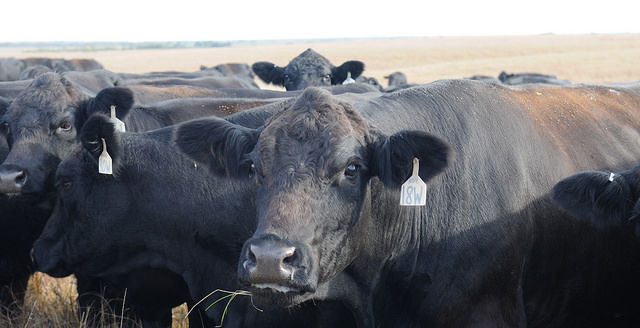Beef cattle can weigh 1,000 pounds or more, so it is ironic one of the most detrimental antagonists to cattle are insects weighing only milligrams. Horn flies, or Haematobia irritans, are an extreme nuisance to cattle and ranchers, and they can cost cattlemen a lot of profit in the long run.
“Horn flies are the biggest economic impactor on beef cattle whether you know it or not,” said Dana Zook, Northwest Oklahoma area livestock specialist.
Although there are multiple types of flies that can be seen on cattle, horn flies are known for staying on the back and belly of the animal. Zook says horn flies can cause a number of problems for cattle including irritation from the fly bites, blood loss, less efficient use of forage and diminished milk production due to stress, which then leads to lighter calves and disease transmission such as mastitis.
Additionally, she says horn flies are a greater problem in pastured cattle than confined cattle.
“These flies rely on existing manure pats,” she said. “They lay their eggs in the manure, those eggs develop into larvae and they live there until they can fly off to a cow. In a confinement setting, you don’t really have pacts of manure because they are broken up by the foot traffic. In a pasture, those pacts stay intact and are avoided by grazing cattle.”
Zook says it becomes exceedingly stressful for a cow to deal with hundreds of flies at once with each fly taking up to 30 blood meals a day. Oklahoma State University Extension considers 200 to 300 flies per animal to be an acceptable economic threshold of infestation for cattle treated with a fly control chemical. Zook says nothing will keep all the horn flies off, but 200 to 300 is an acceptable level for cattle to still perform well.
The options to treat horn flies include insecticides such as pyrethroid, organophosphate and macrocyclic lactone/abamectin. Methods to use the insecticides include ear tags, pour ons, sprays, insect growth regulators and dust bags, rubs and oilers.
The life cycle of a horn fly is usually from seven to 21 days depending on temperature. Horn fly populations typically exist from May to September, however, Zook says those populations have been extending from April to October because temperatures in past years have risen sooner in the year giving the horn fly optimal conditions to hatch earlier.
“They thrive in 90 degree temperatures and above and the hotter it is, the faster they regenerate,” she added. “Because of their fast life cycle they are also able to develop resistance to insecticides very quickly. You can have 10, 12, 15 or 20 generations on one cow and with all those generations their DNA is able to develop a resistance to those chemicals.”
Because of the temperature changes and resistance to chemicals, cattlemen have been even more challenged to keep the horn fly numbers at bay.
Insecticidal ear tag study
Zook, along with Tommy Puffinbarger, Alfalfa County Extension specialist, Justin Talley, OSU livestock entomology professor, and Kylie Sherrill, OSU entomology graduate student, conducted the 2018 Alfalfa County insecticidal ear tag demonstration to better assist cattlemen with the horn fly issue.
“We wanted to see what month was the best time to put in a fly ear tag as far as effectiveness of fly control and evaluate fly counts for each month,” Zook said.
For the demonstration, the Extension team members used Tri-Zap Fly Tags made by Y-Tex. They tagged 30 cattle in April, 24 in May, 15 in June and an additional 25 were untagged in a control group. Photos were taken in April of all the groups even if they did not have tags yet. Side profile photos were taken of each cow one to two days prior to the initial fly tag treatment then every month until the demonstration ended in September. The photos were sent to OSU where students counted each visible fly on the cow.
At the end of the demonstration, the results showed cattle tagged in April experienced low fly counts. The group’s highest fly count was in September with 400 flies counted. Cattle tagged in May and June followed the control group’s trend of higher fly counts until they were tagged in their respective months and had a sudden drop of fly population. All tagged groups experienced similar fly counts in the months they had fly tags to protect them. The control group served as a comparison for what animals would experience if they were untreated. June and September were the months with the largest count of horn flies, with 700 to 800 flies detected on the untagged control group in each of those months.
The Extension team also compared the fly counts cumulatively and learned the April-tagged cattle never had more than 600 flies on them throughout the entire summer because they were protected from the beginning of the fly season. May-tagged cattle had more flies on the whole than April-tagged cattle, because they were protected one less month and the same was true with the June cattle. However, Zook says the conclusions to draw from the project are not as simple as they seem.
“April turned out to be the best time to tag in the year 2018, but we are hoping to do some more studies to learn more about it,” she said. “We’re not saying tagging later in the summer is bad, but we believe May is probably the optimal time to tag your cattle.”
The major take-home point is delaying tagging until June accounts for higher fly counts cumulatively, although not to the level of the control group.
Lacey Newlin can be contacted at [email protected].


